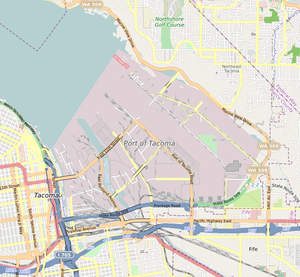Tag:landuse=port
 |
| Description |
|---|
Port area handling commercial traffic (it is recommended to use rather landuse=industrial, industrial=port) |
| Group: landuse |
| Used on these elements |
| Useful combination |
| Status: approved |
| Tools for this tag |
Consider using rather landuse=industrial with industrial=port providing the same information. |

An area tagged as landuse=port describes a coastal industrial area where it's handled commercial traffic.
Usually the area is operated by a single entity and is focused on a particular type of cargo (for example a container terminal handles loading and discharge of container ships with particular infrastructure).
How to map
The preferred method is to enclose the land area dedicated to the handling of a particular cargo (or traffic) with a way or a multipolygon. The tagging requires landuse=industrial and industrial=port on the area, and it's possible to define the category port=* (and the location with port:type=* ) and eventually the handled cargo cargo=*.
If you used landuse=port, please consider migrating to landuse=industrial + industrial=port.
landuse=port
industrial=port
landuse=harbour
Port category
| CATHAC category | value | Definition | Usage |
|---|---|---|---|
| Cargo terminal | A terminal for handling cargo (See cargo=*). | port=cargo | |
| RoRo-terminal | roro | A terminal for roll-on roll-off ferries. | port=roro |
| Seaplane terminal | seaplane | A terminal for seaplanes. | port=seaplane |
| Fishing harbour | fishing | A harbour with facilities for fishing boats. | port=fishing |
Cargo
| CATHAC category | value | Definition | Usage |
|---|---|---|---|
| Tanker terminal | tanker | A terminal for the bulk handling of liquid cargoes. | cargo=liquid_bulk |
| Container terminal | container | A terminal for container ships. | cargo=container |
| Bulk terminal | bulk | A terminal for the handling of bulk materials such as iron ore, coal, etc. | cargo=dry_bulk |
| General cargo terminal | cargo | A terminal for handling general cargo. | cargo=general |
Port:type
To distinguish different port types.
| Value | Description |
|---|---|
| seaport | "Normal" port (implicit) |
| dryport | Inland port directly connected to a seaport, where can be performed customs operations |
| deep_water | The water depth can allow berthing of bigger vessels |
| inland_port | On river or lakes |
Multiple values handling
If you need to assign multiple values, consider modifying the tags as the following example: cargo=container;general becomes cargo:container=yes + cargo:general=yes, see example in office=logistics.
See also
- Naval base for a military area
- Tag:amenity=ferry_terminal for ferry and passenger terminal
- Marina for pleasure boat
- Tag:landuse=harbour for other objects